GIGABYTE F2A88X-UP4 Review
by Ian Cutress on March 24, 2014 11:59 AM EST- Posted in
- Motherboards
- AMD
- Gigabyte
- FM2
Real World CPU Benchmarks
Readers of our motherboard review section will have noted the trend in modern motherboards to implement a form of MultiCore Enhancement / Acceleration / Turbo (read our report here) on their motherboards. This does several things – better benchmark results at stock settings (not entirely needed if overclocking is an end-user goal), at the expense of heat and temperature, but also gives in essence an automatic overclock which may be against what the user wants. Our testing methodology is ‘out-of-the-box’, with the latest public BIOS installed and XMP enabled, and thus subject to the whims of this feature. It is ultimately up to the motherboard manufacturer to take this risk – and manufacturers taking risks in the setup is something they do on every product (think C-state settings, USB priority, DPC Latency / monitoring priority, memory subtimings at JEDEC). Processor speed change is part of that risk which is clearly visible, and ultimately if no overclocking is planned, some motherboards will affect how fast that shiny new processor goes and can be an important factor in the purchase.
Rendering – Adobe After Effects CS6: link
Published by Adobe, After Effects is a digital motion graphics, visual effects and compositing software package used in the post-production process of filmmaking and television production. For our benchmark we downloaded a common scene in use on the AE forums for benchmarks and placed it under our own circumstances for a repeatable benchmark. We generate 152 frames of the scene and present the time to do so based purely on CPU calculations.
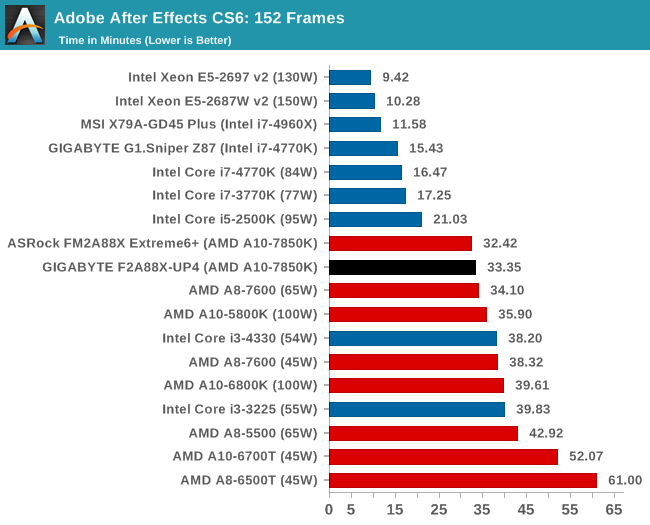
After Effects likes more cores and IPC, although the UP4 does not engage as much Turbo as the Extreme6+.
Compression – WinRAR 5.0.1: link
Our WinRAR test from 2013 is updated to the latest version of WinRAR at the start of 2014. We compress a set of 2867 files across 320 folders totaling 1.52 GB in size – 95% of these files are small typical website files, and the rest (90% of the size) are small 30 second 720p videos.
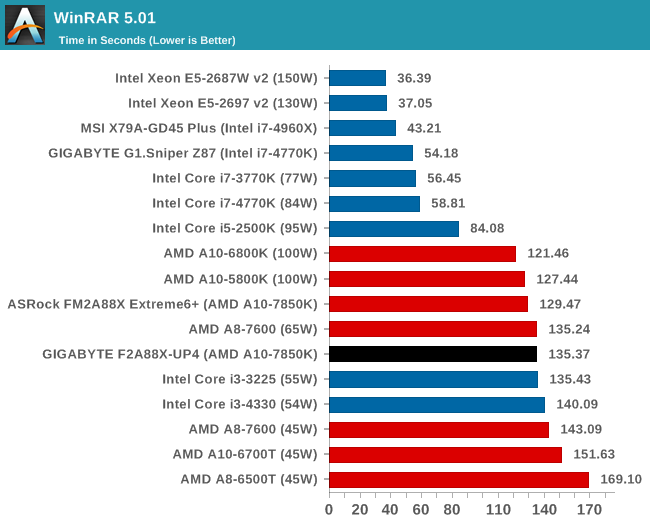
Image Manipulation – FastStone Image Viewer 4.9: link
Similarly to WinRAR, the FastStone test us updated for 2014 to the latest version. FastStone is the program I use to perform quick or bulk actions on images, such as resizing, adjusting for color and cropping. In our test we take a series of 170 images in various sizes and formats and convert them all into 640x480 .gif files, maintaining the aspect ratio. FastStone does not use multithreading for this test, and thus single threaded performance is often the winner.
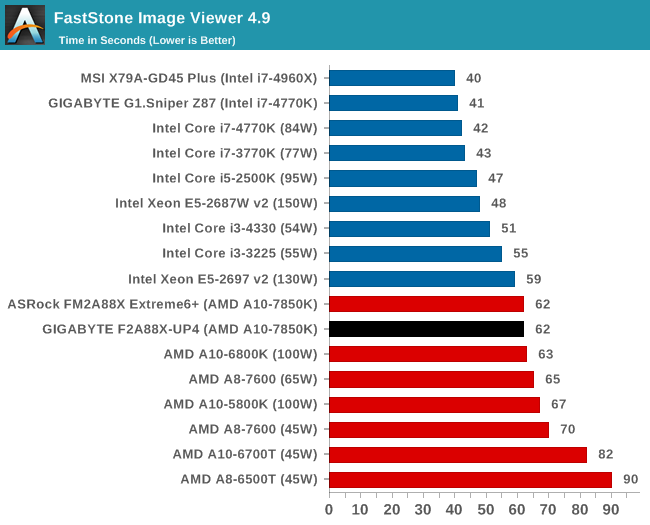
Video Conversion – Xilisoft Video Converter 7: link
The XVC test I normally do is updated to the full version of the software, and this time a different test as well. Here we take two different videos: a double UHD (3840x4320) clip of 10 minutes and a 640x266 DVD rip of a 2h20 film and convert both to iPod suitable formats. The reasoning here is simple – when frames are small enough to fit into memory, the algorithm has more chance to apply work between threads and process the video quicker. Results shown are in seconds and time taken to encode.
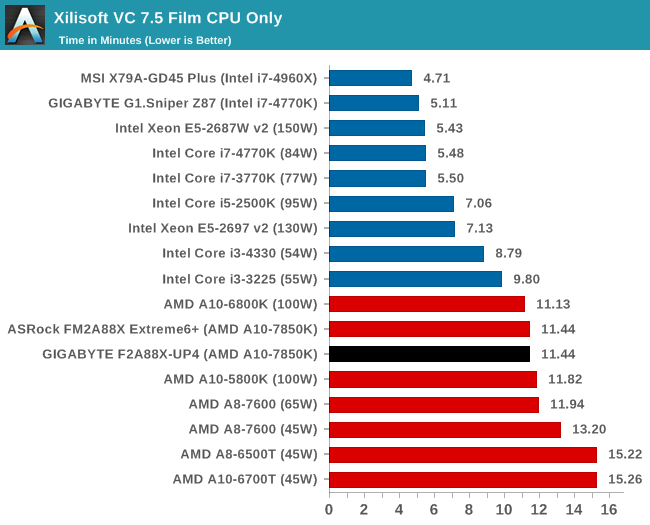

Video Conversion – Handbrake v0.9.9: link
Handbrake is a media conversion tool that was initially designed to help DVD ISOs and Video CDs into more common video formats. The principle today is still the same, primarily as an output for H.264 + AAC/MP3 audio within an MKV container. In our test we use the same videos as in the Xilisoft test, and results are given in frames per second.
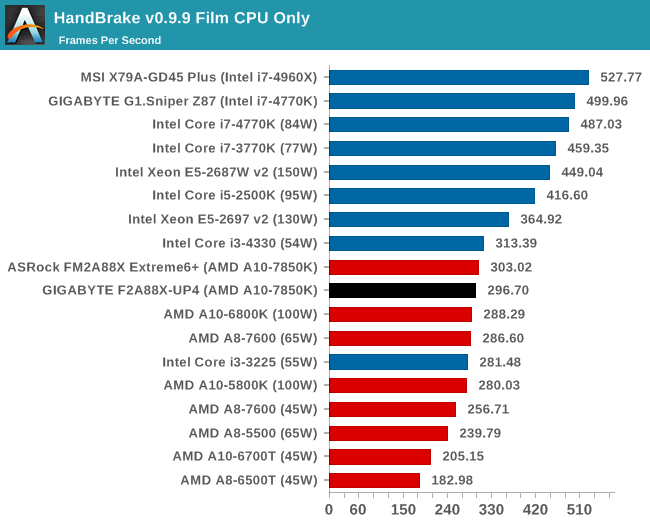
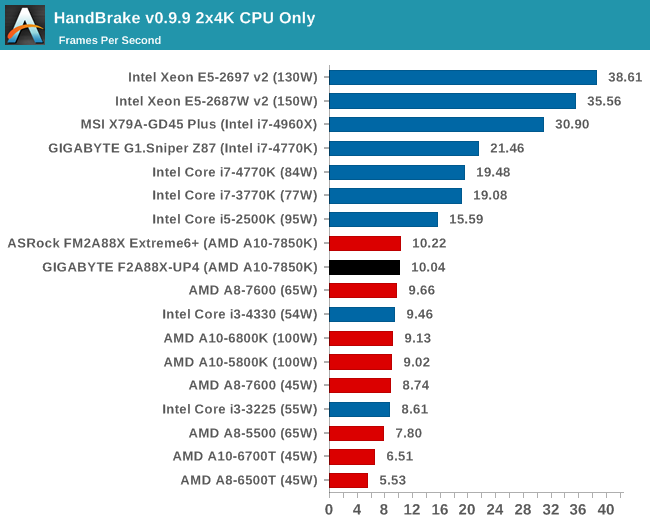
Rendering – PovRay 3.7: link
The Persistence of Vision RayTracer, or PovRay, is a freeware package for as the name suggests, ray tracing. It is a pure renderer, rather than modeling software, but the latest beta version contains a handy benchmark for stressing all processing threads on a platform. We have been using this test in motherboard reviews to test memory stability at various CPU speeds to good effect – if it passes the test, the IMC in the CPU is stable for a given CPU speed. As a CPU test, it runs for approximately 2-3 minutes on high end platforms.
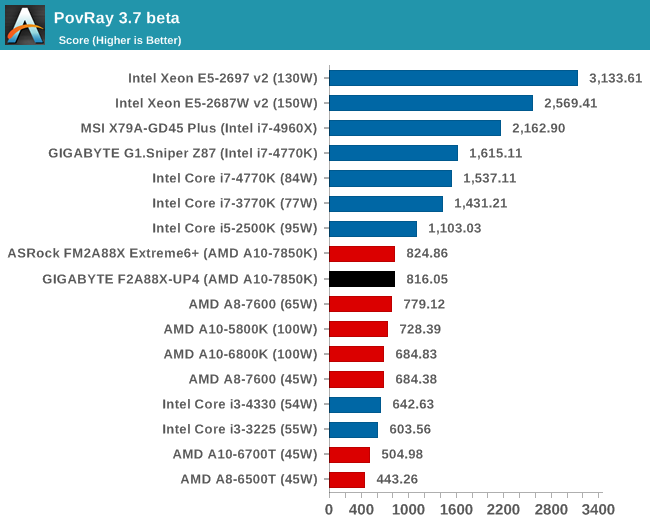










18 Comments
View All Comments
apertotes - Monday, March 24, 2014 - link
The old EasyTune software may end up being a blessing in disguise. The newer Intel software has a nasty issue with global hotkeys and some non-English keyboard layouts. Those hotkeys can not be disabled or remapped and take control of some very usual key combinations like @,# or €.DukeN - Monday, March 24, 2014 - link
Good mining board - inexpensive combined with a cheap AMD proc, even has onboard power button wired in.popej - Monday, March 24, 2014 - link
Again dynamic range "From Graph"? Can't you believe, that numeric value and provided graph are only different presentation of the same result?Noise level drawn on the graph directly depends on FFT size, make FFT calculation with twice the size of data and it will drop by 3dB. RMAA probably draws graph normalized to 1Hz FFT bins, but it is only a convention, nothing there can suggest 102dB DNR.
StevoLincolnite - Monday, March 24, 2014 - link
I'm really not all that interested in ATX sized FM2+ boards.However, where I think there is a gap that needs to be filled is actually in the AM3+ sector.
SERIOUSLY Where are the ITX based AM3+ boards!?
I have a Phenom 2 x6 and an FX 8120 laying around that would love to find their homes in a Mini-ITX system.
meacupla - Tuesday, March 25, 2014 - link
I think it's just not possible to load up an ITX board with that many voltage regulators.Asrock's first FM2 ITX board went up in flames, and an A10 is lower power than Phenom or FX.
bdub951 - Monday, March 24, 2014 - link
ITX is where FM2+ shines. We really need a look at the various FM2+ ITX offerings. I've dealt with the GA-F2A88XN-WIFI and while the board itself is very nice, the BIOS and software really needs some work. Overclocking is a mixed bag on FM2+ due to the CPU throttling to 3Ghz under iGPU load. iGPU overclocking is the most important distinguishing factor between boards and the GA-F2A88XN-WIFI (possibly the rest from Gigabyte too) doesn't appear to allow the iGPU to clock beyond 960Mhz even though you can set it higher in BIOS.DrMrLordX - Monday, March 24, 2014 - link
The 3 ghz P5 state throttling under iGPU load can be defeated:http://www.overclock.net/t/1459225/i-have-custom-l...
. . . but it isn't an elegant solution. I think the UP4 has been reported to restrict iGPU overclocking to 960 mhz by some folks at overclock.net, but my memory is fuzzy on that point.
bdub951 - Tuesday, March 25, 2014 - link
I'm a little disappointed that Anandtech isn't able to look into issues like this. I think it's pretty important to know these things when determining what CPU and MB to go with. Why even bother with determining what CPU OC a board will support when the use of your iGPU just causes it to throttle to P5 making the OC useless. Given this appears to be a TDP limitation that is designed into Kaveri, wouldn't it make more sense to determine the iGPU OC??Now whether this TDP limitation affects the iGPU also remains to be seen but there are reports that the iGPU throttles to 450Mhz randomly causing stuttering when it's OC'd. I believe MSI afterburner shows this.
Regardless, I think it's time for a little more disclosure from AMD as to whats happening. This is supposed to be an unlocked processor but it's clearly locked. Whether you lock via clocks, multiplier, or TDP is irrelevant, it's still locked.
DrMrLordX - Tuesday, March 25, 2014 - link
Allegedly, MSI Afterburner can be used to defeat iGPU throttling, though at least one person I've talked to has voiced the opinion that the throttling behavior may be due to excessive polling by software such as . . . MSI Afterburner (and the person I am citing may step forward to elaborate, if he wishes).As far as the p5 state throttling, some boards are supposedly able to defeat that behavior by toggling a setting such as advanced power management (APM), but it is not 100% clear whether or not that is effective. Some boards do not offer this option in their UEFI.
I agree that more disclosure and coverage of throttling issues on Kaveri would be nice. Published benchmarks are all potentially tainted by throttling behavior. I don't fault the reviewers really, Kaveri is just an odd chip. Power delivery seems to be a major concern on the FM2+ platform when hosting a Kaveri CPU.
rozquilla - Monday, March 24, 2014 - link
The link to the AMD A10-7850K (ES) processor actually links to the Intel Core i7-4960X.